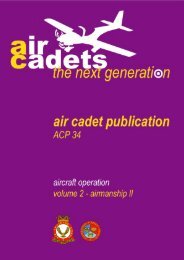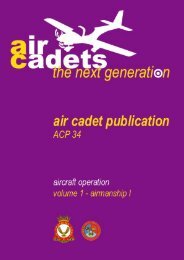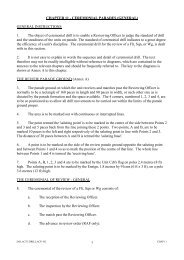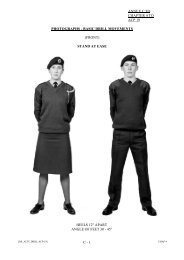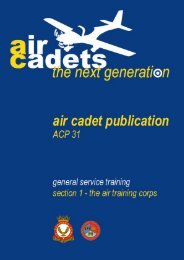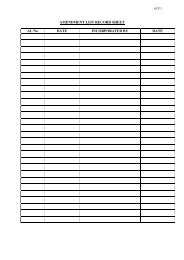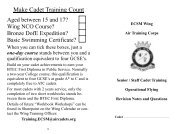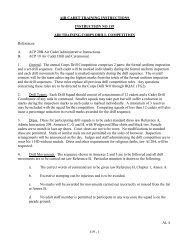Leading Cadet ECSM Wing Revision Guide - 967 Air Cadets
Leading Cadet ECSM Wing Revision Guide - 967 Air Cadets
Leading Cadet ECSM Wing Revision Guide - 967 Air Cadets
You also want an ePaper? Increase the reach of your titles
YUMPU automatically turns print PDFs into web optimized ePapers that Google loves.
CHAPTER 2 RULES OF THE AIR<br />
Just as drivers must obey the Highway Code to<br />
avoid accidents, pilots must obey ‘Right of Way’<br />
rules.<br />
Rights of Way for Different <strong>Air</strong>craft Types<br />
There are four main types of aircraft - balloons,<br />
gliders, airships and conventional powered aircraft.<br />
Balloons cannot be steered, therefore all other<br />
types of aircraft must give way to them.<br />
Gliders are manoeuvrable, but have no engines and<br />
fly at low speeds. They have right of way over<br />
powered aircraft and airships.<br />
<strong>Air</strong>ships do have engines and can avoid collision<br />
more easily than gliders or balloons. For this reason<br />
they must give way to gliders and balloons.<br />
Conventional powered aircraft must give way to<br />
balloons, gliders and airships.<br />
Rights of Way for Similar Types<br />
When two aircraft are approaching head-on, each<br />
must alter course to the right.<br />
If two aircraft are on converging courses, the aircraft<br />
which has the other on its right must give<br />
way.<br />
An aircraft being overtaken has right of way. The<br />
overtaking one must avoid the other by turning<br />
right.<br />
Navigation Lights<br />
In addition to flashing ‘anti-collision’ lights, aircraft<br />
carry navigation lights to help pilots judge<br />
which way other aircraft are travelling at night.<br />
Balloons carry a single red light suspended below<br />
the basket.<br />
Conventional powered aircraft have a red light on<br />
the port wingtip, a green light on the starboard<br />
wingtip and a white light on the tail.<br />
Who must give way to a balloon?<br />
a) Only airships. b) Only conventional powered aircraft.<br />
c) Only gliders. d) All types of aircraft.<br />
Who must give way to a glider?<br />
a) Only conventional powered aircraft. b) Only airships.<br />
c) All types of aircraft except balloons. d) Only balloons.<br />
Who must give way to airships?<br />
a) Conventional powered aircraft. b) Balloons.<br />
c) Gliders. d) All types of aircraft.<br />
Who must give way to a conventional powered aircraft?<br />
a) None. b) <strong>Air</strong>ships.<br />
c) Only gliders. d) Only balloons.<br />
Which of these types of aircraft has to give way to all of the<br />
others?<br />
a) Balloons. b) <strong>Air</strong>ships.<br />
c) Gliders. d) Powered aircraft.<br />
If two aircraft are converging at the same height, which<br />
must take avoiding action?<br />
a) The aircraft that has the other on its right.<br />
b) The aircraft that has the other on its left.<br />
c) The slower of the two.<br />
d) The faster of the two.<br />
According to the rules of the air, if a faster aircraft is catching<br />
up with a slower one which is ahead and at the same<br />
height, how should the faster aircraft overtake?<br />
a) By maintaining height and overtaking on the starboard<br />
side of the slower aircraft.<br />
b) By maintaining height and overtaking on the port side<br />
of the slower aircraft.<br />
c) By climbing at least 1000 feet higher and then overtaking.<br />
d) By descending at least 1000 feet lower and then<br />
overtaking.<br />
All aircraft carry navigation lights at night. Suspended<br />
below the basket, a balloon carries:<br />
a) Two red lights.<br />
b) One red and one green, red above green.<br />
c) One red and one green, green above red.<br />
d) One green light.<br />
e) One red light.<br />
What are the standard navigation lights carried by a powered<br />
aircraft?<br />
24<br />
PORT STARBOARD TAIL<br />
a) Red White Green<br />
b) Green White Red<br />
c) Red Green White<br />
d) White Red Green<br />
CHAPTER 1 AIR TRAFFIC CONTROL<br />
At RAF airfields all movements of aircraft, both on<br />
the ground and in the air are monitored by <strong>Air</strong><br />
Traffic Control (ATC). The ATC controllers operate<br />
from the ‘control tower’.<br />
The Aerodrome Controller<br />
<strong>Air</strong>craft on the ground (and vehicles) in the manoeuvring<br />
area and in the local circuit are handled<br />
by aerodrome controllers (sometimes called airfield<br />
controllers), who work in a glass walled control<br />
room on the top of the control tower.<br />
Communication from the control tower to aircraft<br />
and vehicles on the airfield is by VHF and UHF<br />
RT. (Very High Frequency and Ultra High Frequency<br />
Radio Telecommunications)<br />
The Approach Controller<br />
<strong>Air</strong>craft outside the circuit, but within the airfield’s<br />
area of responsibility are handled by the approach<br />
controllers. This includes aircraft departing and<br />
joining the circuit and aircraft making instrument<br />
approaches.<br />
Other controllers responsible for the safety of aircraft<br />
flying between airfields are located at <strong>Air</strong><br />
Traffic Control Centres (ATCC’s) or <strong>Air</strong> Traffic<br />
Control Radar Units (ATCRU’s) neither of which<br />
are necessarily located on airfields.<br />
The Runway Controller<br />
Busy training airfields often have a runway controller<br />
located in a red and white chequered caravan<br />
located near the touch-down point.<br />
Telephone Communication<br />
Good communications between airfield control<br />
towers, ATCC’s and ATCRU’s are vital. All are<br />
linked by direct cables (landlines). The network<br />
was known as the Defence Fixed Telecommunication<br />
System (DFTS), now the RAF Telecommunications<br />
Network (RAFTN).<br />
Helicopter Operating Areas<br />
Helicopter landing areas are identified by a large<br />
(4m by 2m across) letter ‘H’.<br />
17<br />
Which building at an airfield houses the people who monitor<br />
aircraft on the ground and in the air?<br />
a) <strong>Air</strong> traffic coordination room.<br />
b) <strong>Air</strong> traffic coordination tower.<br />
c) <strong>Air</strong> traffic control tower.<br />
d) <strong>Air</strong>borne traffic control room.<br />
Which of the following controls the movement of both<br />
vehicles and aircraft in an airfield’s ground manoeuvring<br />
area?<br />
a) Ground controller. b) <strong>Air</strong> controller<br />
c) Approach controller. d) <strong>Air</strong>field controller.<br />
Which of the following would normally work in a glass<br />
walled room in the control tower?<br />
a) Approach controller. b) <strong>Air</strong>field controller.<br />
c) Ground controller d) <strong>Air</strong> controller.<br />
The main method of communicating from the control tower<br />
to aircraft and vehicles on an airfield is by:<br />
a) HF and MW RT. b) VHF and UHF RT.<br />
c) RAFTN. d) Tele-talk.<br />
Which of the following controls aircraft departing from and<br />
arriving at an airfield?<br />
a) Approach controller b) Ground controller.<br />
c) <strong>Air</strong> controller. d) <strong>Air</strong>field controller.<br />
What does the abbreviation ATCC represent?<br />
a) <strong>Air</strong> Traffic Control Coordination<br />
b) <strong>Air</strong> Traffic Control Centre.<br />
c) <strong>Air</strong> Traffic Coordination Centre.<br />
d) <strong>Air</strong> Traffic Control Conference.<br />
What does the abbreviation ATCRU represent?<br />
a) <strong>Air</strong> Traffic Control Relay Unit.<br />
b) <strong>Air</strong> Traffic Control Radio Unit.<br />
c) <strong>Air</strong> Traffic Control Radar Unit.<br />
d) <strong>Air</strong> Traffic Control Response Unit.<br />
Which of the following would normally work in a red and<br />
white caravan?<br />
a) <strong>Air</strong>field controller. b) Ground controller.<br />
c) Approach controller. d) Runway controller.<br />
What does the abbreviation DFTS represent?<br />
a) Defence Flexible Telephone System.<br />
b) Defence Fixed Telecoms System.<br />
c) Defence Force Trunking System.<br />
d) Defence Fixed Teletype System.<br />
What does the RAF call its system of telephones?<br />
a) RAFPN b) RAFCN c) RAFTS d) RAFTN<br />
A marker 4m high by 2m across in the shape of a letter ‘H’<br />
identifies what?<br />
a) A helicopter servicing area.<br />
b) A helicopter loading area.<br />
c) A helicopter target area.<br />
d) A helicopter landing area.



